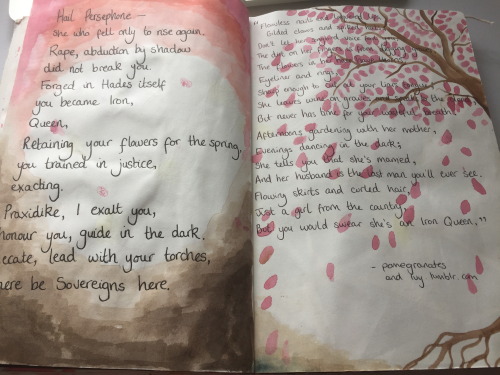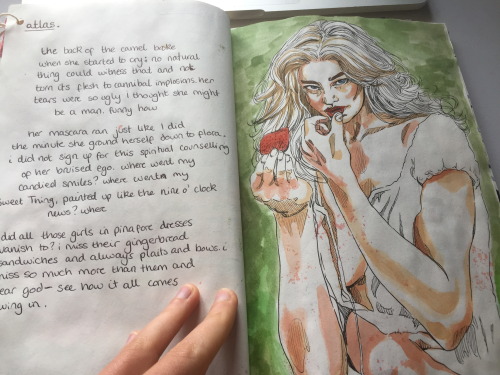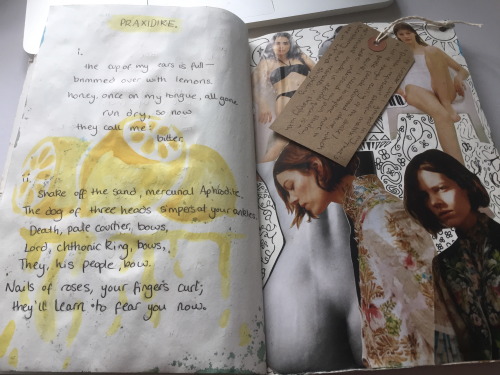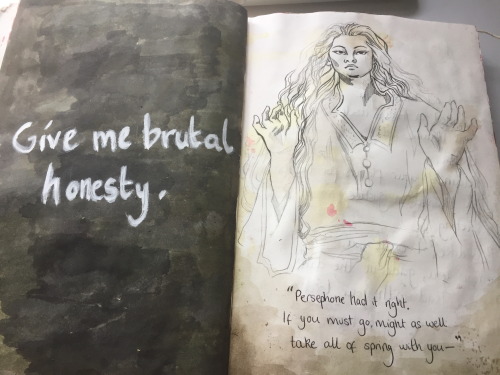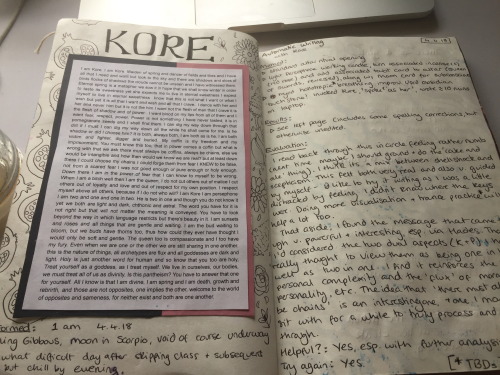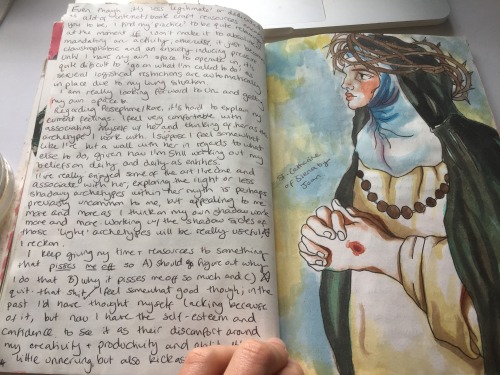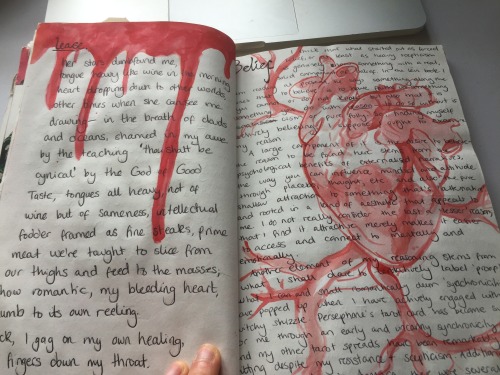Devotional JournallingI saw a post recently by @thepastelpriestess on devotional journalling and wan
Devotional JournallingI saw a post recently by @thepastelpriestess on devotional journalling and wanted to throw my own two cents in + attach some examples. I’m someone who can very easily get paralysed by my own perfectionism, so when I looked around for DJ examples, I either found ones that were enormously elaborate with a level of detail and technical skill that I would never be able to keep up consistently, and knew I would always be dissatisfied with the result, or found examples where it was very much about getting content down and in the journal with minimal fuss. Both are methods/styles I would love to be able to pull off, but my anal retentiveness means I tend to need a kind of middle ground. So, this is a post for how I found I could keep in that middle ground with a devotional journal. Ideas for what you can include: Keeping a kind of ‘dear diary’ series of entries, where you reflect upon certain occurrences or things that are affecting you through the lens of your deity/ies. For example, I worked a lot with Persephone and the idea of one person holding a lot of multiplicities within themselves, and examined what was going on in my life in relation to her myth and altering qualities. Shadow work.This may be specifically working through shadows that come up in relation to your deity/ies and their myths, qualities, or your own personal experiences with them, or it may be more general, and you might call on your deity for guidance, support, and insight. Automatic writing. I personally find it very difficult (and messy) to do automatic writing by hand because of my lack of spatial awareness and hand-eye co-ordination, so I do mine on my laptop and then print them out. Again, these can be tied to your deity, or on any subject you like; I like to call on my deity to guide me through whatever it is I wish to address in the writing session. Devotional Creation. Artwork, poetry, anything you can glue in, anything I’m not thinking of that’s creative. I found it really helpful to just go into my journal, pick a blank page (it didn’t have to be the next one available) and just draw/paint/write whenever I was in the mood, rather than making it an obligation and a task. The work/pictures I tended to include in my journal were inspired by/working with Persephone, but just creating in the name of/under the guidance of your deity can be just as devotional alone, so whatever inspires you, go for it. It’s really satisfying to come back to it and put something on the opposite page later, and see how the puzzle pieces of your inspiration fit together unplanned. Related research notes. In studying the craft/shadow work/tarot in general, I found lots of bits and pieces that reminded me of my deity, or that felt like relevant pieces to work through with them. I put these in both as long-form writing, or picked out specific quotes that were particularly meaningful to me, and gave a whole page to a few words. Ritual recordings. I know a lot of people like to keep their DJ at their altar/wherever they do meditations and rituals, and write or work in it in ritual space. I personally couldn’t do this in my available space, and also found the idea of writing whilst doing ritual work too overwhelming, so instead I kept a much messier ‘jottings’ journal at my workspace, and if there was anything that really spoke to me, I’d write it up in my devotional journal.Stop and start pages. I found I didn’t always consistently keep my journal. Often, guilt would mean I’d abandon this sort of project; because that was the opposite of what I wanted, I instead tried to work through that guilt with ‘return’ pages. I’d give a page, or a couple of pages, to simply writing through what had happened to the interim, to gently examine why the lapse may have occurred, and to acknowledge why that break was probably needed. I found doing a couple of easy, low-processing pages after these was often useful— drawings, putting in quotes of meaningful items I’d come across in the ‘pause’, something that let me reconnect with the process of journalling without getting too bogged down in guilt or heavy matter. You may find you want to get straight into shooting the shit, but that was just my preference. Whatever reminds you of your deity. For some people, this is perhaps historical practices, or personal gnosis. Songs, food, shows, films, colours, all of it. I found particular symbols and signs came to really represent my deity to me (so, so many roses. Boy howdy.) What’s really fun is listing these down, or drawing them out, and then writing about why they’re tied to your deity for you. Looking into the deeper symbology, perhaps analysing what is suggested in this connection. Anything that lets you get beneath the surface of the lists you can find of Deity X = Symbols Y and lets you find meaning in those connections, or in your own connections.How to deal with perfectionismEvery tip I ever found for this was pretty much a dolled up way of saying ‘just get over it’ or ‘relax’. I’m working on learning to relax, but my neuroatypical brain struggles with that. So, I wanted to include here some practical tips for dealing with perfectionism when journalling. This is what works for me, so if you’re also a perfectionist and don’t vibe with this, that’s cool, take what works and leave the rest:Do not try and do bulk text in fancy handwriting. I personally get too frustrated with the end product AND the effort, and also, hand cramp. I loathe my handwriting, but also enjoy the process of physically writing. I’d recommend either typing and printing out text, or handwrite, and see the next item. Or a mix of both.Low-effort prettying up pages: If you don’t have a set of watercolours, I 100% recommend grabbing some; you don’t need fancy ones, I use a 10 quid set that has lasted me 6 years of heavy use. (watercolours last forever, they are a gift). When buying your journal, consider checking if the pages can handle watercolours; mine isn’t watercolour paper, but it’s a little fancy, so it handles everything well. Having said that, I’ve bought bargain buy notebooks before that survive just as well. Consider testing out yours in advance before doing anything to elaborate. Watercolours let you do neat colour tricks that add something visually interesting in 30 mins or so. The easiest ones are doing a light gradient, or a vignette. There may be particular effects or colours that remind you of your deity. If there are basic symbols or patterns that do so, these can make really nice backgrounds to put over bulk text. If you don’t feel confident doing these, look up examples or tutorials online. Stencils also exist, and make really nice patterns. Basic, repeating patterns like checkers or circles or just one symbol drawn over and over look AMAZING when they’re done, and don’t require anything too elaborate or a sense of proportion. I also find it very meditative to do the repetitive action. My key points for this are find what you enjoy the doing of, because it’ll make you a lot more likely to stick with your journal. My other top tip is with watercolours over text, keep them pale. Several times I’ve gone too intense, and though I can still read the text, it’s a little trickier on some pages. If you have a blank page that you want to fill, but you have little creative energy at the moment and you don’t want to write: collages. Collages are also a gift. You get to collect things you love and that are beautiful to you, and voila, they’re in. For me personally, I use a lot of fashion magazines, as they tend to have more diverse imagery; fashion shoots get pretty creative with location and theme. Magazines also tend to have shiny pages, which is an effect I like. If you’re printing your own pictures and want that same magazine shine, you can by special photography paper, which is a little pricier, but isn’t unrealistic for a few spreads. However, bear in mind that sometimes, especially soon after printing, photography paper can smudge. I’d advise leaving the prints to dry for a few days before handling. Help, I forgot to write something down. People do all kinds of adding in extra pages and flaps and so on tricks, which is awesome. I get too annoyed at how bulky it makes my workbooks, so as you can see in the pictures above, I use tags. If you need to add a bunch of information, then I’d add a new page, but tags are great for ‘oh, i forgot a paragraph’ additions. If you also hate adding flaps, another idea is numbering your pages. If you number your pages, you can borrow from bullet journalling at at the bottom of the page where you want to add information to this ‘section’, put a little arrow in brackets to the page number where you’ll continue ( > 50) etc. I tried to draw something and it’s ugly as heck. I’d make sure you do everything drawings wise in pencil first in your journal, just so you don’t get too furious with it. If you’ve inked/painted something that you loathe though: 1) leave it for a few days. I hate a lot of things when they’re first finished, then when I come back to it a few days later, I find I actually kind of like it. 2) If you still really find it frustrating that this is in your journal, and you’ve worked through if you want this journal to allow your mistakes to be present and permitted, but definitely want this drawing ‘out’; you can either remove the page (use a pen knife if possible), or stick something over. A thick piece of card is a good one to stop anything showing through. This has been a very long post, and nonetheless, I’ve likely forgotten things. I might do a video tutorial on setting out pages or collaging at some point if I ever figure out technology, but I hope that this long-winded rambling can maybe help anyone who is like me with their perfectionism and struggles with guilt/frustration around these things. -- source link
Tumblr Blog : bleedingsymbollic.tumblr.com
#devotional journal#devotional journalling#journalling#devotional writing#witchcraft#hellenic pagan#information#bs speaks#bs bom
